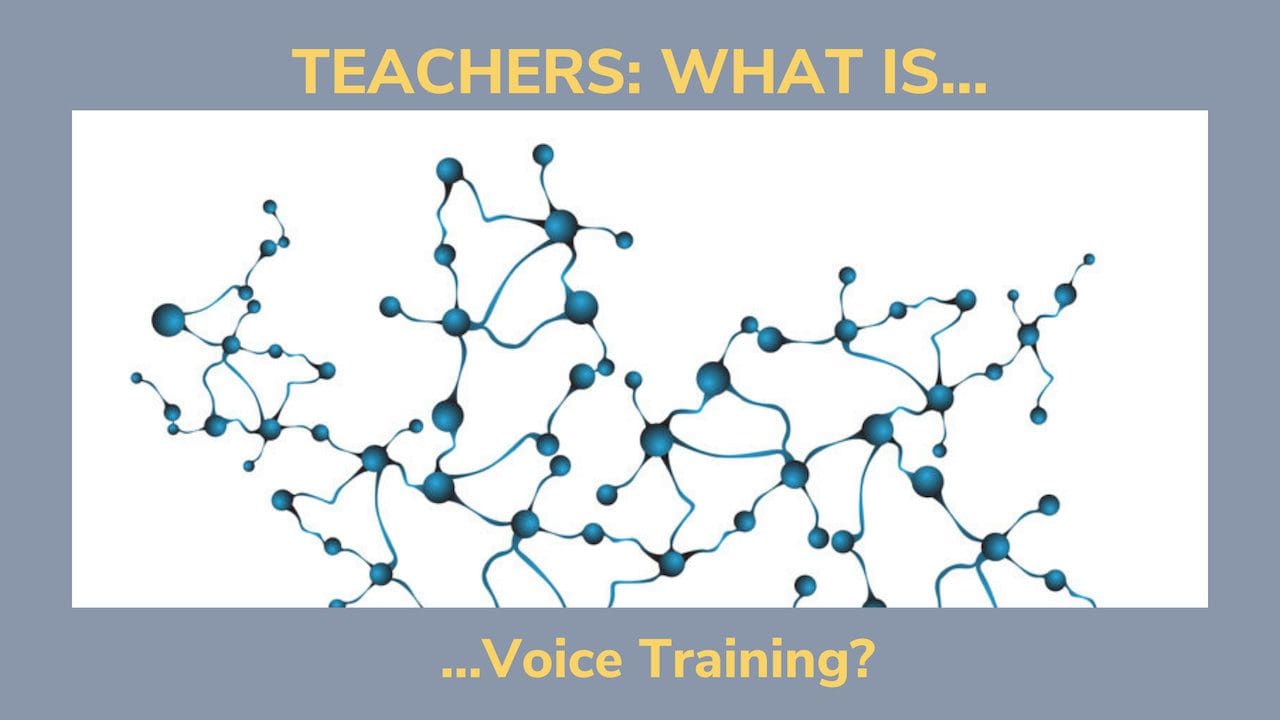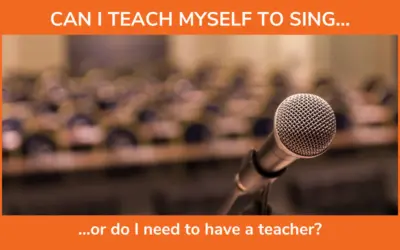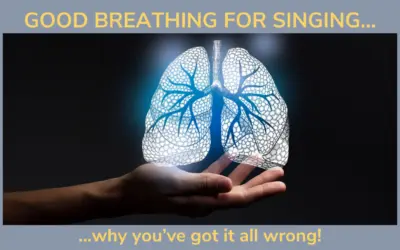Inside This Article
I’ve been running a course for the last few years, TEACH WITHOUT TEACHING, which has become the heart of my TEACHER TRACK Program. And, the idea that that course centers around is that it is possible to teach a student whatever it is you feel you could teach them without directly “teaching” them at all, but by creating the conditions for them to learn what they need and want to learn in their own way, in their own time, with your guidance. Similarly, when it comes to the idea of “voice training” in the comprehensive sense, my philosophy could be summarized by the phrase: TRAIN WITHOUT TRAINING.
Now, to unpack this, first you must read my previous blog post, SINGERS, WHAT IS VOICE TRAINING?, to get a sense of what I mean by training and how it can be reframed. Then we can talk about how to facilitate such a process. So, go on… go read that and then come right back here.
Ok, so now that you’ve read that… hopefully, you’re asking the question:
“That sounds great, but how the heck would I be able to facilitate something like that and how could I do that within lessons, classes and the usual venues as a voice teacher?”
Well, it’s possible people. And here are some clues as to how you can begin to do so.
1. Know that, as the facilitator, you both know and don’t know at all times.
We go to school. We learn terminology. We learn about history, techniques, voice types, anatomy, musicality… so many things as part of our own voice training. But, none of it is *really* real or true. These are concepts, constructs and ideas about what singing is, should be and/or how one should do it. In other words, it’s all only relatively true.
This is so when it comes to the voice science aspect of our field as well. It’s helpful, it’s interesting and it’s sometimes useful, but… is it ultimately true? No. Science is always changing; we’re always learning more. And, often, what we thought we knew just isn’t so true later on. So, this is why I say, it is best to hold the attitude that we know and don’t know at the same time. It’s like we are well-informed fools. And when we can own this and get comfortable with this, amazing things can happen. We can discover, learn and be surprised.
We can also make sense of the known through exploration of the unknown. It’s very dynamic and exciting once you get the hang of it. And leading lessons from this attitude is an essential starting point for learning to facilitate the “ordered wilding” of any student’s voice training without training.
2. Trust the system, guide the person.
Now, part of the “unknown” is the person you are working with. They are a different person from any other. A unique system. They may have similarities to other people, as well all do, but we are all also very different. To be with another person in learning, as a guide to their learning, means to humbly know and not know again and again and again.
We cannot just slap some info on top of a system and expect it to change in any fundamental way. That information needs to be accepted by that system through the consciousness of that person. So, no matter what we might know or not know, we must always guide the person/system to come to their own knowing/not knowing. It would be too easy if we could just say,
“this is what’s wrong, fix it this way” or “do it this way and it will be better.”
That person’s system – we can call it their nervous system as a shorthand, perhaps – has amazing powers to learn, re-organize and integrate new skills into their repertoire of actions, but they must go through or be led through a process of self-discovery for it really to settle into their system and truly become their own.
But, that’s what all of our nervous systems are designed to do, so we must trust that. We can trust that. The question is, how can we facilitate this process for any unique individual in such a way that allows them to tap into this inner power to learn and integrate that learning in an organic way? And, also in such a way that through enough experience and facilitation they can learn to do so with and for themselves?
3. Everything/Anything can be a learning experience (or not)
All you have to do is google “vocal exercises” or look at YouTube videos about voice training to know that there are LOTS of vocal ideas out there and exercises to go along with them.
How a vocal exercise usually works is this: It has a goal (specific outcome) and then a sequence of some sort (sounds, movements, etc.) that are supposed to, when practiced and repeated enough, lead to that outcome. Well, this is a suspicious idea in the first place… that by repetition of a sequence we will reach a desired outcome… why? We are not machines.
Again, we are a system and not only *a* system, but a system of many systems (digestive, circulatory, respiratory, reproductive, etc.). Trying to re-organize the whole system – which is what is necessary for integrated action – by trying to force it, in a superficial way, one part or sub-system at a time, to do something “good” is not genuine learning. It’s like putting a colored gel over a drawing and thinking that the drawing has actually changed color. It has not. What has been accomplished, if anything, is the superimposition of something on the surface of the system. No learning. No integration.
Sometimes it “works” – meaning that the appearance of learning or change seems to have occurred – but it is only superficial. And, this is revealed over time because the effect wears off or gets “thrown off” by the rest of the system which is, of course, primary. I think you see the problem.
BUT, there is some good news… any exercise, any idea, any “good practice” that is functional and in alignment with whole-system thinking can be turned into a learning experience even if it originates as an exercise. And, if (and only if) that particular system in the course of that learning experience decides that this new possibility is a good idea, it can be accepted into the entire system and integrated into it dynamically. This is what I mean when I use the word “learning.”
4. Shifts in experience when noticed, celebrated and accepted can reset the entire system and the action being explored (e.g. singing) in lasting ways.
In a lesson, when we are facilitating learning we are creating the conditions for that person/system to have a new experience of themselves and in the process update themself to themself. This can happen around any topic or focus. But when it happens well, there is usually a shift – pretty quickly – in the system around that focus.
It could be a specific sound or a specific movement being explored, i.e. a particular movement of the tongue.
Maybe it’s a movement they never learned how to do – or forgot somewhere along the way – and through awareness, self-sensing, moving, coordinating other parts in support of that movement, exploring variations and other options… gradually it clarifies and becomes possible. Then it can be expanded to become easier and easier.
Then it can be integrated into voicing and singing in ways that allow the system to see how useful that movement can be and when to choose it or not. When the system sees that it can be useful it will adopt it as an available option for future use. Over time, it may even become the most available option – but not in a rigid way. Because, as a system of systems, we need to move in and out of so many different patterns and options fluently and fluidly in order to keep finding and re-finding an optimal organization for whatever we are doing at any given moment in time.
It’s so dynamic. Like a dance of dances, all different, all happening at once, but all coordinating and adjusting to and for each other without losing their own identity.
And when this happens, even if it is a small improvement, it must be celebrated and enjoyed so that the whole system knows it’s important and worth keeping.
5. Understand networked, non-linear learning – complexity theory in action.
Since we are a complex system of systems that together create an internally networked organism (aka “us”), in order to facilitate learning (aka voice training) that can be adopted and integrated into the whole system one must use the system itself to do the learning. That’s why sometimes I like to say “The lesson isn’t just for you – the conscious you – it’s really for your system – the whole of you, including the parts you are not aware of.”
So, sometimes we need to facilitate the “getting out of the way” of the conscious part (the part that wants to understand and control everything externally) in order to let the deep intelligence of the organism do the real learning in its linear/non-linear way. When we can facilitate this (for ourselves and others) true systemic learning takes place. And, since all of the internal systems are networked and interlinked, they all need to be in on the learning no matter what system may be the focal point.
Because, for something to be truly systemically functional it must be accepted by the whole system and there must be a balance of all of the systems in the system in order for any one system to function well. This is very complex, but it’s possible, once you understand it.
So, to be more concrete, the vocal system is only one system among many systems within the singing self. And in order for the nervous system to be able to make functional and successful adjustments for any vocal action, it must also manage and organize all of the other systems, proportionally, along with any vocal adjustment at any given moment. When all of the systems are in good enough balance to accommodate any change anywhere in any of the systems and do that again and again, moment by moment, no matter which system may be leading, there will always be functionality (or enough functionality, because it can always improve even when its really good). This is the basis for voice training that is function, flexible and integrated.
So, when learning any particular vocal skill, one must always include and keep in mind all of the other systems and allow the deep organismic intelligence of the nervous system to organize that optimally along the way. As a facilitator of vocal learning, you are facilitating whole system learning, regardless of the vocal task or surface learning intention.
By the way, this is why many of my lessons and classes often have what I call “collateral benefits” beyond just singing, because when one learns in this whole system way, all of the systems improve together. Your breathing will improve; your standing, your digestion, your thinking, your bicycle riding, your creativity… all of it, all at once.
6. Understand “long-view learning” – complexity concretized.
One of my favorite things to do when I’m teaching a student (or group of students) for extended periods of time like in the undergraduate university schedule (10-12 private voice lessons each semester for four years, for example) is to get to know them in the beginning, observe their strengths and weaknesses, awarenesses and non-awarenesses in a non-judgmental way (to myself) and then begin to imagine who they could (and will!) be in four years time as a singer, as a person, and as a learner. And I hold that in my mind at all times as we learn together over the years.
Then I start with their strengths and guide them, experientially, so that their strengths get stronger, easier and more and more dynamically coordinated. Then, I start introducing variations within what they are already good at that are necessary variations for what they are not so good at (yet).
In musical theater programs in which a student is expected to eventually be proficient in so many styles (“Legit”, Classic MT, Contemporary MT, Pop/Rock, etc.), they usually come into the program with one of these being their strength. I start there.
Let’s say it’s a “Legit” soprano. We work with their “legit” singing and start introducing variations necessary for “belting” within the “legit” explorations. I never say that this is happening. I would do this kind of exploration for the whole first year. Then in year two we begin working with “belting” by bridging from the “legit” to “belting” styles, connecting the dots across the styles and gradually making it more conscious. The next thing they know, they’re “belting” with ease and joy and we got there in both fun and functional ways.
This is what I think of as “long-view learning” and it is a wonderful way to facilitate the rounding out of one’s vocal style “surfing” ability so that one can move from style to style, organization to organization, easily, fluidly, authentically, artistically, and at will.
7. Understand integration and let the person/system do the rest.
Integration is a word I use a lot.
Basically, it’s referring to the process by which a new piece of learning that has been accepted by the whole system through a separate, developmental learning process is placed back into total vocal action (i.e. a song, style, character, etc.).
I often do this by using a reference in the beginning and end of any lesson (sometimes returning to it throughout, too.) and asking the student to “just sing” without trying to make anything particular happen. “Just sing.” And the thing that has been learned, by the power of the intelligence of the deep organism in that person/system will bring that learning into the singing almost automatically. (If that doesn’t happen, it’s ok. More lessons may be needed or some bridges from learning to using it in context may need to be created but, by and large, it happens on its own.)
When this happens, “integration” is occurring. The learning is integrated into the system, integrated into a specific action and, in the system, integrated into the general category of “singing.” This is another way to describe dynamic voice training. This is an important step to facilitate well in a way that always respects the whole system and utilizes the power of organic learning. When we get it just right there is a seamless transfer of learning from discovery to mastery and it is so exciting for both student and teacher! It’s like witnessing a miracle. Much of the art of vocal facilitation lies in this aspect of the process.
So you see it is so important to know and not know, to learn to lead and follow or more accurately lead by following the person allowing the deep intelligence of their beautiful system of systems – that is designed to learn in this complex, dynamic way – to do the rest, which it will do beautifully given the right timing, input and conditions.
Maybe this all sounds “airy-fairy” or too abstract, but no… it’s simple and real, and is, in my opinion, what voice training should be all about. And, in my TEACHER TRACK program I will show you how it works and how to facilitate such deep learning for singers, actors and voice users in your own way – building on what you already know/don’t know.
It’s a truly experiential program so you will not only get the theory, models and techniques, but you will most importantly be introduced to a method of working through your own experience that will allow you to easily generate your own ways of working from the inside out. Check it out here.
This article is part of a series titled “HOW TO BE A BETTER VOICE TEACHER FOR YOUR SINGING STUDENTS”.





Wow!! I am enjoying the enjoyment of enjoying this integrative and inclusive sense of process and personal and immersive learning. Thank you!